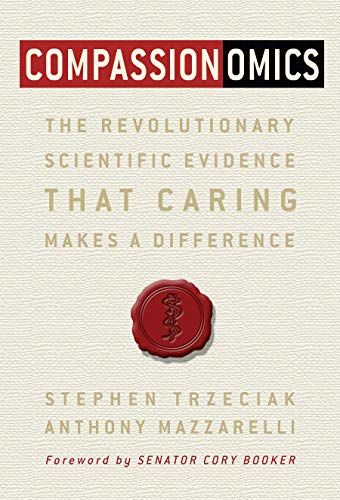
Compassionomics: The Revolutionary Science Evidence that Caring Makes a Difference, by Stephen Trzeciak and Anthony Mazzarelli.
medical students, we frequently discuss how burnout negatively impacts a provider’s life, including their physical well-being, mental health, and close relationships. However, one aspect of burnout we often overlook is the profound effect that it has on our patients. Perhaps the most important thing that a emotionally exhausted provider struggles with is providing compassion—if your personal tank isn’t full, it’s hard to share with others.
In my first year in medical school in my Value-Driven Healthcare elective class, I learned about patient experience. I realized that listening to direct feedback from patients and elevating their voices gives us the best chance to improve compassion in healthcare, and I knew I wanted to be involved.
Over the summer, I completed an internship with the patient experience team and facilitated a book club on the book Compassionomics: The Revolutionary Science Evidence that Caring Makes a Difference, authored by physicians Stephen Trzeciak and Anthony Mazzarelli.
Trzeciak and Mazzarelli make the case that the presence (or lack of) compassion touches all parts of healthcare and can have profound effects on everything from patient self-efficacy to actual psychological and physiological health benefits. This is the first of a series of two articles exploring the themes of Compassionomics with practicing providers.
In the first section of the book, the authors discussed the difference between empathy and compassion. We often talk about empathy and compassion as interchangeable ideas, but the authors made a point to explain the difference. They describe empathy as an emotional response to another’s pain that involves an authentic desire to help. Compassion means using these feelings to take action. In other words, compassion occurs when one uses the feelings of empathy to take action on behalf of someone else. This distinction stood out because it highlights that compassion is an action word, and that taking action on behalf of others is fundamental to showing true compassion.
It got me thinking—how do medical professional show compassion to their patients on a regular basis? How can providers use compassion to improve their patients’ lives? I spoke with Wendy Macey, a Physician Assistant and the Medical Director of University of Utah Health's Greenwood Health Center. Wendy is regularly recognized by her patients for her empathy and compassion.
Tanner Nelson: The authors describe the difference between empathy and compassion. Empathy is about the feeling of concern for others, while compassion is putting that concern into action. For you, what is the difference between empathy and compassion?
Wendy Macey: I’ve been lucky to have a long career; I’m in by 22nd year of being a PA. Empathy and compassion can get tangled. Both can make you the best at what you do, but it can also break you. We have to remember that we’re traveling this road together, that while you are on your own journey, you are going to experience others traveling their road. It’s a balancing act. I do have a deep, profound, meaningful sense of connection with my patients, but I use that as a life preserver for myself to have boundaries. I know that my decisions have to stay at a particular level, and I can be a champion to fight for a patient. But it also needs to stop, or it can lead to fatigue. You have to remember that you’re the lifeguard.
TN: How do you balance compassion for your patients and having enough emotional space for yourself?
WM: We all need a cushion of resilience. For me, my team is my cushion. I rely on them, and they remind me that I’m not doing this alone.
The partnerships you surround yourself with are really important, and our colleagues can help support and sustain you.
I tell my students; medicine is a team sport. We’re a squad or a scrum. We’re in this together. If something is too close for me, or you, it’s ok to look at each other and say that was hard. We don’t have all the answers. Its ok to be human in front of your patients and say, I’m going to ask for help. Asking for help from a colleague shows our patients that we too have a pathway of resiliency and that we’re collaborative. It shows our faith in each other. As a student, relying on your colleagues is a healthy modality to start practicing early on.
TN: We know that once in practice, you don’t get a lot of time with patients to build a relationship. How do you build a relationship that leads to trust in a short period of time?
WM: Years in trauma and urgent care teach you how to get to know a patient quickly. Sometimes it is just simply listening without interrupting, even just for 30 seconds.
Read the room: Building compassion with patients starts with what I like to call ‘taking the temperature of the room.’ I pay attention to the patient’s body language and what they’re wearing. I pay attention to things like band t-shirts, shoes, and earrings, all of the small details that can tell me if someone is retracted and not interested. I match my own tone. I lower my voice up and down, and I can be very quiet if I need to be. I’m an observer and that goes a long way. I think my colleagues that are observers tend to get a lot of mileage out of that skill.
Let your patients lead: It's their visit, not ours. Give your patients a chance to introduce themselves and explain why they’re there. We may be seeing 30 patients that day, but they're seeing one of us. It's their time, and although it is short and we’re responsible for guiding them, just let them be for a minute. I try not to come in with too much of an agenda.
Focus on your body language: Even though you are on a tight schedule, try to slow down and focus on the gentleness of your tone. Take a second to think about your answers before you respond. Try not to jump right in with your agenda – let your patient set the pace. You can learn a lot by simply saying, “Hi, I'm Wendy. What’s up?”
Set the tone for calmness: We often forget that many people fear going to the doctor. They're afraid of being judged, they're afraid of being told something scary, and they're afraid of being told that they're wrong or that they’ve done something incorrectly.
As the constant for your patients, you must be ready to steady and guide them through their fear.
Validate their concerns: Imagine a patient comes to you concerned that they might have Alzheimer’s. Instead of brushing off their fear, try to validate their feelings and make them feel heard. You might say: “I understand your concern since your mom had Alzheimer's at 89, and it’s on your mind.” You might follow that up with, “You’re 52 and it seems like you’re doing fantastic, but I will print off some articles and have you meet with social work to look at positive aging models.”
If you’re short on time, let them know, “I want to make sure we address all your concerns. Let’s get you scheduled back another day soon, so we have more time.”
TN: Research cited in the book shows that physicians miss 60% to 90% of emotional cues from patients. Why do we miss so many opportunities to show compassion? What can we do about it?
WM: As a medical director, I field complaints. The number one complaint I hear is that the provider didn’t believe me. I hear “they didn’t want to hear me or talk about a problem I had or validate me.” I see both sides. On the one hand, we’re not going to give morphine or oxycodone for a sore throat. But I also see the patient’s perspective, where we have missed the opportunity for validation. Perhaps the patient is worried that they have something serious because they are scared. I don’t want to ignore a patient’s problem or worry.
So much can go back to our own training days. There are simple things that can help, like sitting down and being level with a patient. Instead of standing, typing, and looking down on a patient, I make sure to sit so that the compassion feels more real.
How it feels for patients
Wendy Macey is the only primary provider I would ever consider going to. Her compassion, dedication to her patients, ability to not only listen but respond to what is being said, and dedication to the mental heatlh aspects of medical care has not been matched by any other provider I have ever seen. Wendy is incredible and I could not recommend her enough to anyone and everyone!
Wendy is a fantastic provider. She is always so knowledgable and informative. She is also very good at making you feel seen and heard. It feels like she really cares about my mental outcomes. I am always impressed with the level of service and care I recieve from Wendy and her staff - this is why I come out of my way to Greenwood.
Wendy Macey is the most compassionate provider as everyone knows, but she went above and beyone with my 14 year old. She spoke to her about her hobbies, her symptoms and diagnosis, her treatment options. We recieved the highest level of care and we can't thank her enough. The reassurance we recieved regarding her health and a plan in place gave us a piece of mind.
How much time do providers spend listening to patients?
Drs. Trezeciak and Mazzarelli highlight 3 successive studies looking at how long it takes before provider interrupts their patient. In 1984, researchers found on average, providers waited 17 seconds before interrupting their patient at the beginning of a visit. The authors comment “At that time, the medical community took notice…a large number of medical schools, training programs, and continuing medical education programs added communication skills and techniques to the curriculum.” A repeat study in 1999 found that the time to first interruption was 23 seconds. Mayo Clinic led a new study in 2018 and found that the time had decreased to 11 seconds. Researchers have found that patients need, on average, 29 seconds to state their main concern.
Tanner Nelson
Wendy Macey
Health care is full of high emotion—especially right now. Thankfully, there’s a simple framework we can follow to de-escalate with compassion. Hospitalist and UACT co-director Claire Ciarkowski introduces NURSE: a simple mnemonic for responding with empathy.
Learning to listen is not only a leadership skill—it’s a life skill. Leadership training specialist Jess Burgett shares three practical tips for harnessing the power of listening with intent.
Our work has high stakes, and it’s natural we feel a deep sense of responsibility. Ally Tanner teaches us that trust helps lighten the load.
